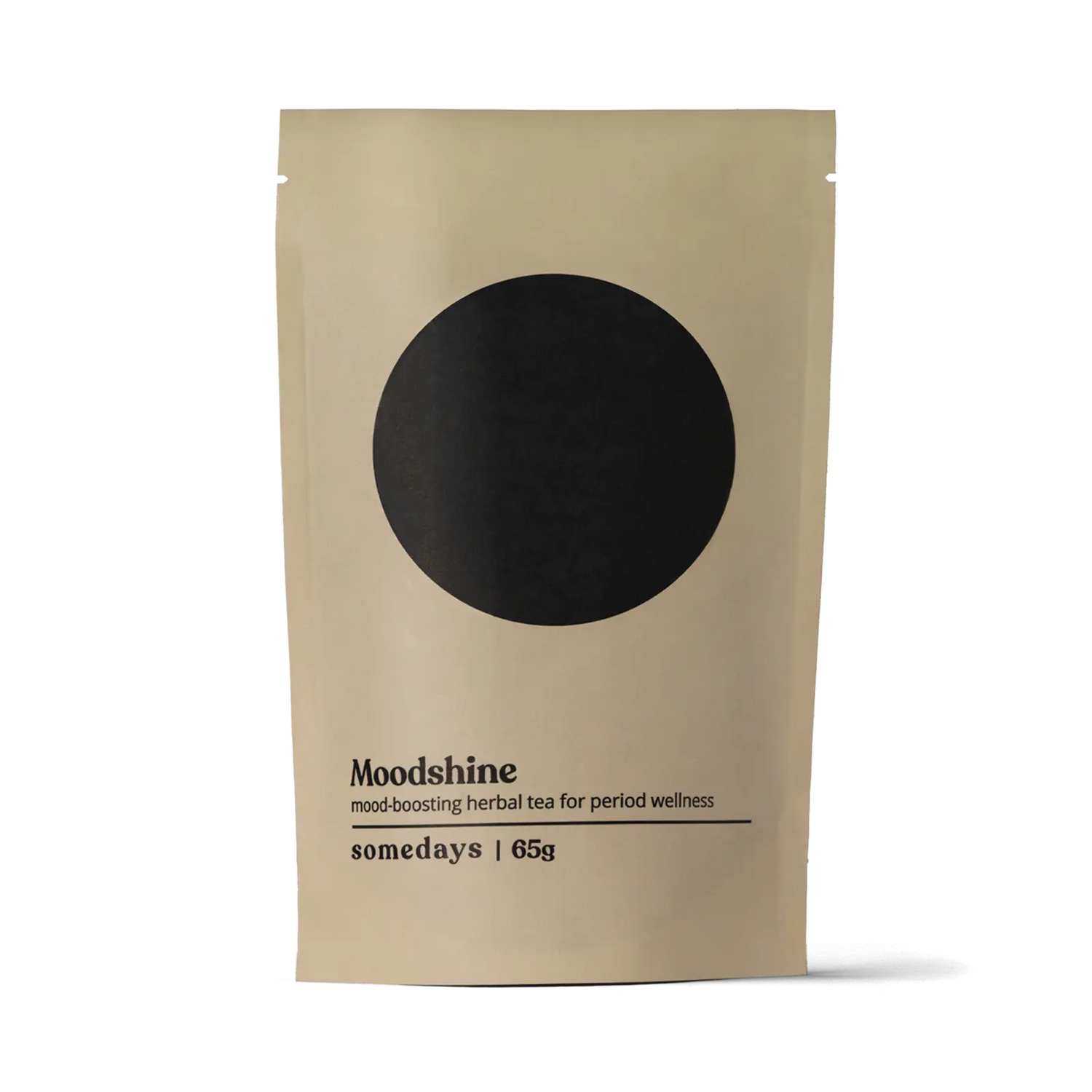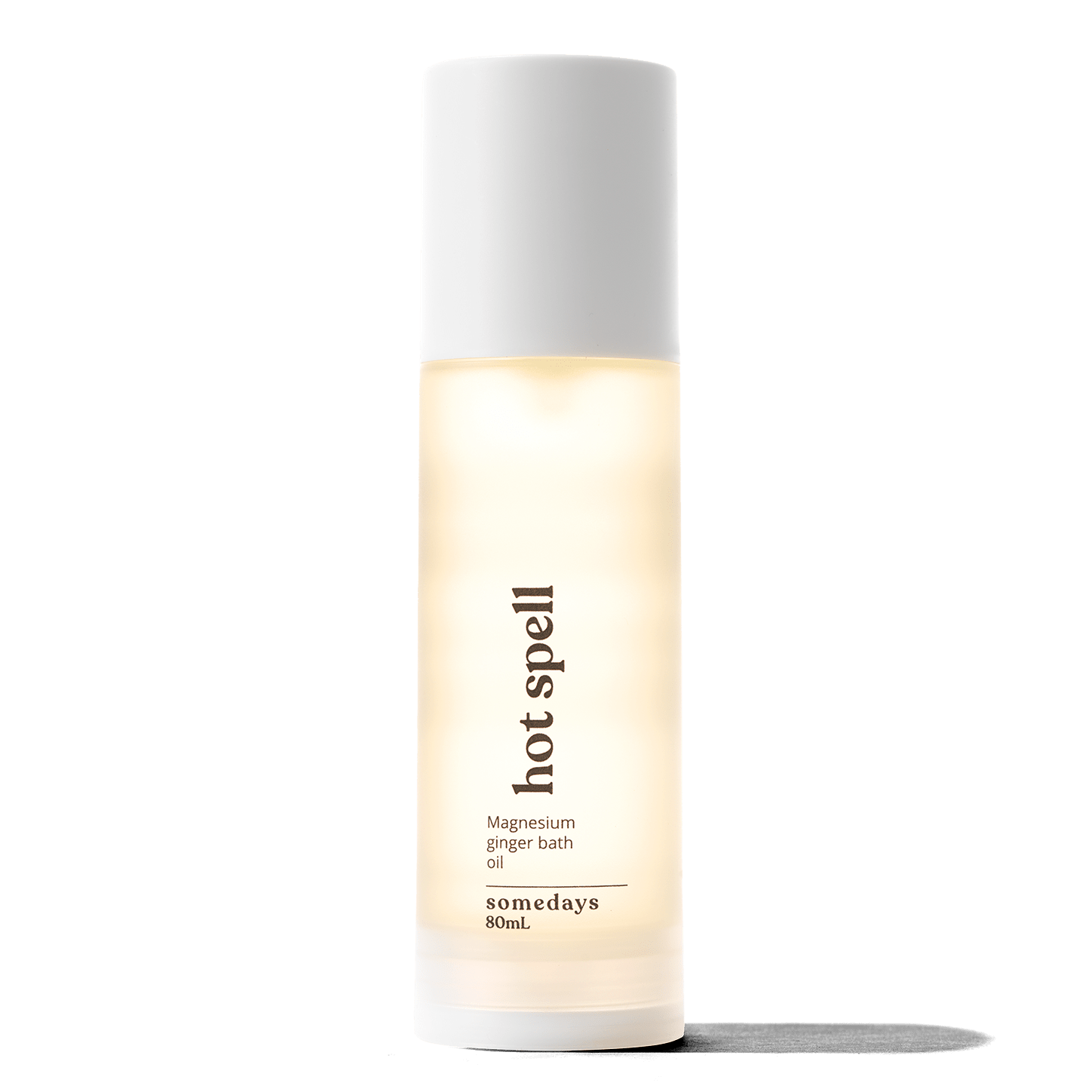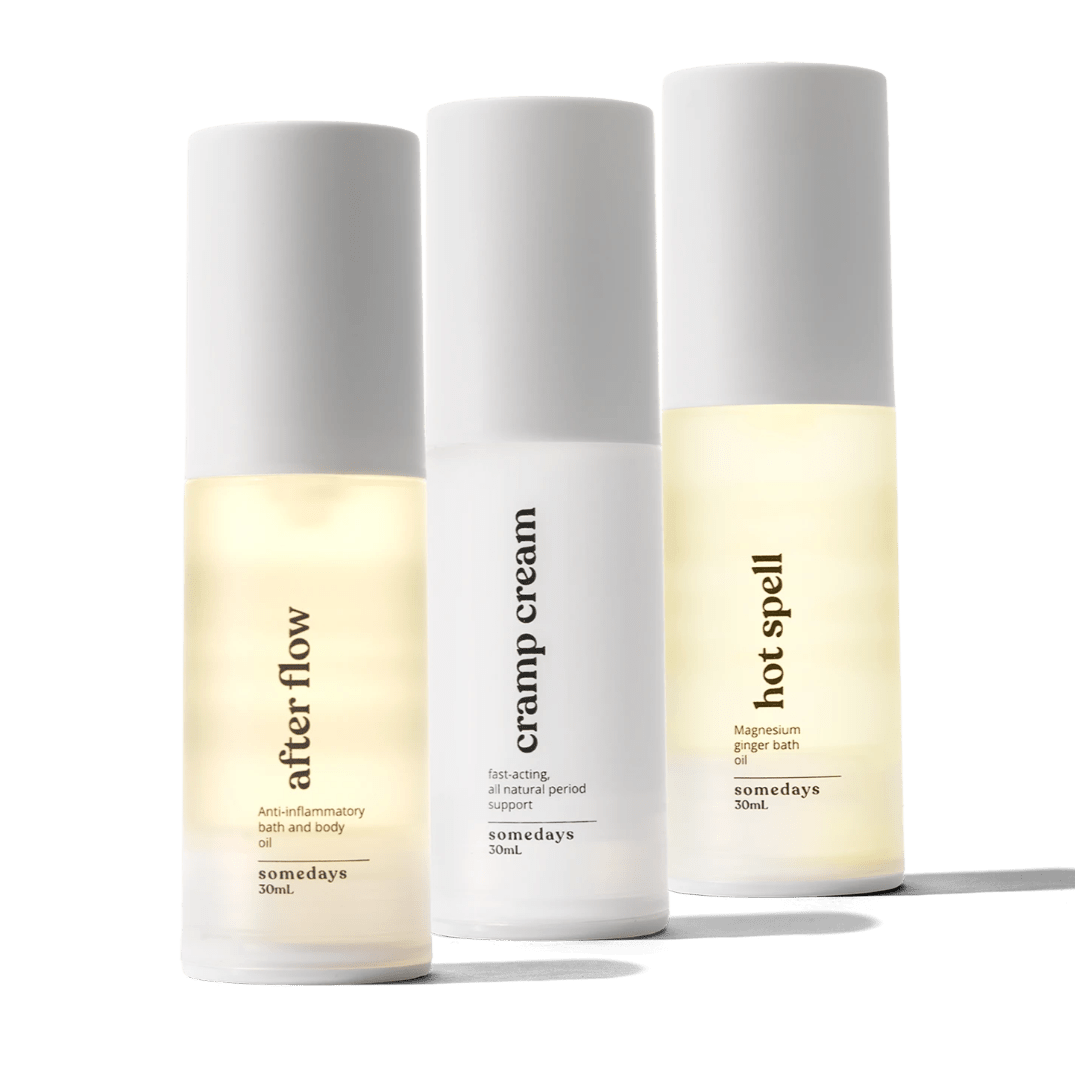The Four Phases of Your Menstrual Cycle

Are you synced with your menstrual cycle? Women and folks with uteruses who menstruate are always cycling along the four phases of the menstrual cycle, whether they're aware of it or not. Each body is different, but the flow of hormones that governs the menstrual cycle follows a similar pattern for all menstruating people.
Curious what that means for you?
As a neurodivergent person, being in flow with my cycle has changed how I live my life and interact with the world. It’s given me tools and language to check in with my body, and to be clear on my abilities and boundaries in the moment in a way that’s expansive and generative.
Becoming aware of your natural cycles can support you toward body literacy, period pain relief, and more embodied ease, safety, and pleasure as you connect with your body and your needs. Once you become familiar with your cycle, you can work with your body and not against it.
Tapping into your cycle is an invitation toward self-discovery and connection with self and others. Let’s dive into menstrual cycle literacy and give you the tools you need to chart the four phases of your menstrual cycle.
What are the four phases of the menstrual cycle?
The menstrual cycle follows the same four phases, in the same order, every time. First is 1) menstruation. Next comes 2) the follicular phase, then 3) ovulation, and finally 4) the luteal phase—which leads into menstruation again. Whole cycle length (from day one of menstruation to day one of the next menstruation) is about one month, though it changes from body to body and from cycle to cycle. It can last anywhere from twenty-one to forty days. It can be regular from cycle to cycle, or irregular—which means your cycle length changes from one cycle to the next.
Let’s break it down.
- Menstruation (lasts 3-8 days)
- Follicular phase (lasts 10-22 days, and includes menstruation)
- Ovulation (lasts 12-24 hours, or 1 day)
- Luteal phase (lasts 11-17 days)
Phase one: Menstruation
The menstrual cycle begins with the first day of menstruation. When an egg hasn’t been fertilized or hasn’t attached to the uterine wall, it means no pregnancy took place during the previous cycle. Estrogen and progesterone levels drop, signaling to the uterus to shed its uterine lining. A substance called prostaglandins causes the uterus to contract, which leads to vaginal bleeding. You might bleed for anywhere from 3 days to 8 days.
Right before and during menstruation, you’ll probably feel more tired than usual—both physically and mentally. Folks living with chronic pain might see an uptick in their symptoms while menstruating. That’s because the presence of prostaglandins increases pain sensitivity, which means it lowers your pain tolerance. If your cycles are regular, go ahead and plan a lighter week in your schedule so you can rest more and tune into a slower pace.
Natural methods to relieve period pain include:
Topical Cramp Cream, Heat Pads, Baths & Castor Packs
Phase two: Follicular phase
The follicular phase starts with your period and leads right up to ovulation. This phase lasts about 10 to 22 days, and keep in mind that this timeline includes the number of days you were menstruating. Estrogen rises during this time, which encourages the uterine lining to thicken and grow. A hormone called FSH (follicle stimulating hormone) stimulates the ovaries in preparation for ovulation.
This is the time in your cycle when you have the most energy and can participate most fully in study, activity, work, and general expansion. Got an important meeting to plan? Make it happen while you’re follicular. It’s a good time for going on dates, road trips, you name it.
Phase three: Ovulation
Ovulation (also known as ovulatory phase) is the peak of the menstrual cycle. It’s a quick process and lasts only about 12 to 24 hours. Leading up to ovulation, estrogen increases. This signals to the brain that it’s time to release a hormone called LH (luteinizing hormone). LH surges, and FSH rises too. One of the ovaries releases an egg from a follicle. This is your fertile window. Body-wise, you’ll notice clear, slippery vaginal secretions. This is known as fertile mucus and acts as a natural lubricant.
You might feel more sensual and have more interest in sex during ovulation. This is also the time when you’re most fertile, so pinpointing when you ovulate can be really useful for those who are trying to conceive.
Phase four: Luteal phase
The luteal phase begins right after ovulation. It lasts about 14 days, give or take 5 days on each end. Estrogen levels drop and progesterone ramps up in its place. The follicle that held the egg becomes the corpus luteum. Assuming pregnancy didn’t happen, the corpus luteum breaks down and hormone levels soon drop. Hormonal changes can cause PMS (premenstrual syndrome) or PMDD (premenstrual dysphoric disorder) with symptoms like pelvic pain and mood swings, ranging in severity from light to severe. This leads to your next menstruation, and the start of a new cycle.
You might feel more introspective during the luteal phase. It’s a good time for self-reflection and creative play time. Therapy, real talk, and connection with your community can be heightened when you’re luteal. It’s a good time to connect more deeply with yourself, your boundaries, and your desires.
Ways to support wellness during your luteal phase include:
Drinking mood-boosting teas, A daily lymphatic-drainage routine,
What affects the four phases of the menstrual cycle?
Your menstrual cycle is affected by your lifestyle, your health, your environment, as well as by emotional, intersectional, and relational factors. In other words, your menstrual cycle and its four phases don’t exist in a vacuum. Your cycle can be affected by:
- Seasonal changes
- Stress (be it mental, physical, or emotional stress)
- Infections or diseases
- PCOS
- Endometriosis and adenomyosis
And so much more. It’s actually super validating to chart your cycle and observe how your cycle can change based on what’s going on in your life. Your cycle is like a somatic map—it’s always communicating with you and showing you where you are at.
Does the menstrual cycle happen in the uterus?
You’re probably thinking of the uterus when you think about the menstrual cycle. But the four phases of the menstrual cycle encompass more than the uterus. The whole menstrual cycle happens in the uterus, the ovaries, the hypothalamus, and the pituitary gland.
The ovaries, hypothalamus, and pituitary gland are part of the endocrine system. This means that folks who have had their uterus removed can still experience the phases of the menstrual cycle, minus the bleed.
Wait, I can have a menstrual cycle without a uterus?
Menstruators who have had their uterus removed—like after a hysterectomy for endometriosis, fibroids, or uterine cancer—still have their ovaries, hypothalamus, and pituitary gland. So they still experience hormonal changes and menstrual phases (except menstruation).
That being said, if you’ve had both your uterus AND your ovaries removed, the hormonal flows associated with the four phases of the menstrual cycle will be greatly reduced all around.
What about folks on hormonal birth control?
Many people with uteruses use hormonal birth control to prevent unwanted pregnancies. If that’s you, you might be wondering what’s up with your menstrual cycle and whether the four phases still apply to you. The answer is: not really. All hormonal birth control prevents ovulation from happening, which means your cycles are anovulatory. Some types of birth control are known as monophasic—meaning, one phase. (...As opposed to four!)
The 7 days of your 28-day birth control cycle during which you don’t take active pills create what’s known as a breakthrough bleed, which is different from menstruation.
If you’re on the pill and want to create more intentional phases for yourself like you would have on an unassisted cycle, you can try following moon phases, paying attention to the seasons, and tapping into other rhythms.
Self care, community care, and the four phases of the menstrual cycle
Body literacy and knowing the four phases of your menstrual cycle allows for safer and more pleasurable self care practices. Beyond individual wellness, though, it’s also a tool that can support community care by creating space and language for discussions around accessibility needs and inclusivity based on where you’re at in your cycle.
Having education around menstrual wellness—along with access to tools and strategies and products for menstrual wellness—is what we need in order to move toward period equity and health for all menstruating bodies. Cycle charting your menstrual phases is just one way to get there.
Hot tip: make sure you have your menstrual wellness products on hand when you’re luteal. This is the time of your cycle when you’re most likely to experience pain and other PMS symptoms.
Join our Betterdays community - a weekly newsletter where we break down the latest (TLDR) news, research and breakthroughs related to your reproductive health—with a splash of humour to get you through the tough days.
BIO
Marie White (she/her) is an herbalist and educator. Her work centers on menstrual health, fertility, community care and inclusivity in wellness. A lover of nature and humans, Marie is the acclaimed author of the reference book for all things herbal medicine and reproductive health, The Intimate Herbal. She is the upcoming author of The Herbal Doula (set for release in fall 2024). Marie offers workshops, courses, and one-on-one herbal consultations. Her work dives deep into hormonal cycles, periods, and the herbs and protocols to steer folks who menstruate toward health, wellness and pleasure.

Website: https://www.intimateherbal.com/
Instagram: https://www.instagram.com/intimateherbalism/
Previous Article All Articles Next Article
All ArticlesCramp Cream
Ease period cramps instantly with our plant-based Cramp Cream. Formulated with natural active ingredients that address period discomfort at the root cause, making it an excellent alternative to traditional methods. Cramp Cream lasts up to 3 hours and can be reapplied as needed, anywhere you experience period discomfort.
$32.00
ADD TO CARTSomatic Care Deck
Pain, Pleasure, and Boundaries is a comprehensive and easy-to-use somatic care deck designed to help you explore connection, safety, and acceptance with your body.
$42.00
ADD TO CARTFeel-Good Period Kit
A curated trio designed to bring comfort and ease during your cycle. This set includes:
- Hot Spell Bath Soak (80 ml): Immerse yourself in a soothing bath to relax and unwind.
- Cramp Cream (80 ml): Gently massage onto your abdomen for added relief.
- Flaxseed Heatpad: Snuggle up with this cozy heatpad to alleviate discomfort.
This kit aims to support you through menstrual cramps, muscle soreness, back and leg aches, tender breasts/chest, and joint stiffness. Embrace a holistic approach to self-care with the Feel-Good Period Kit.
Includes: 80 ml Cramp...
$136.00
ADD TO CART





